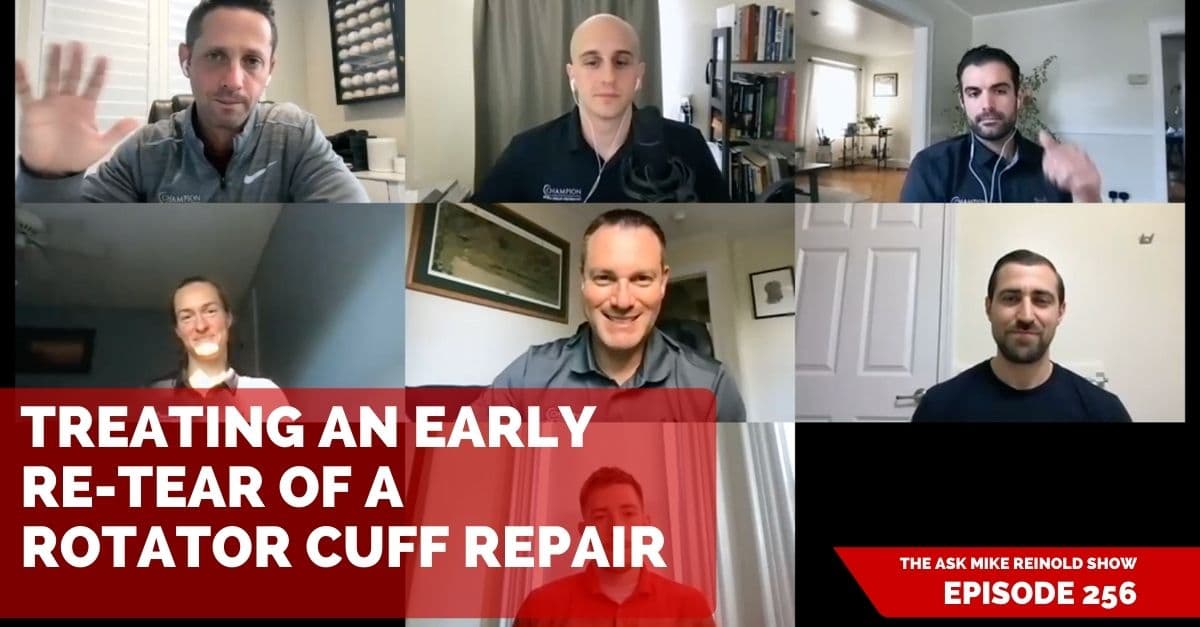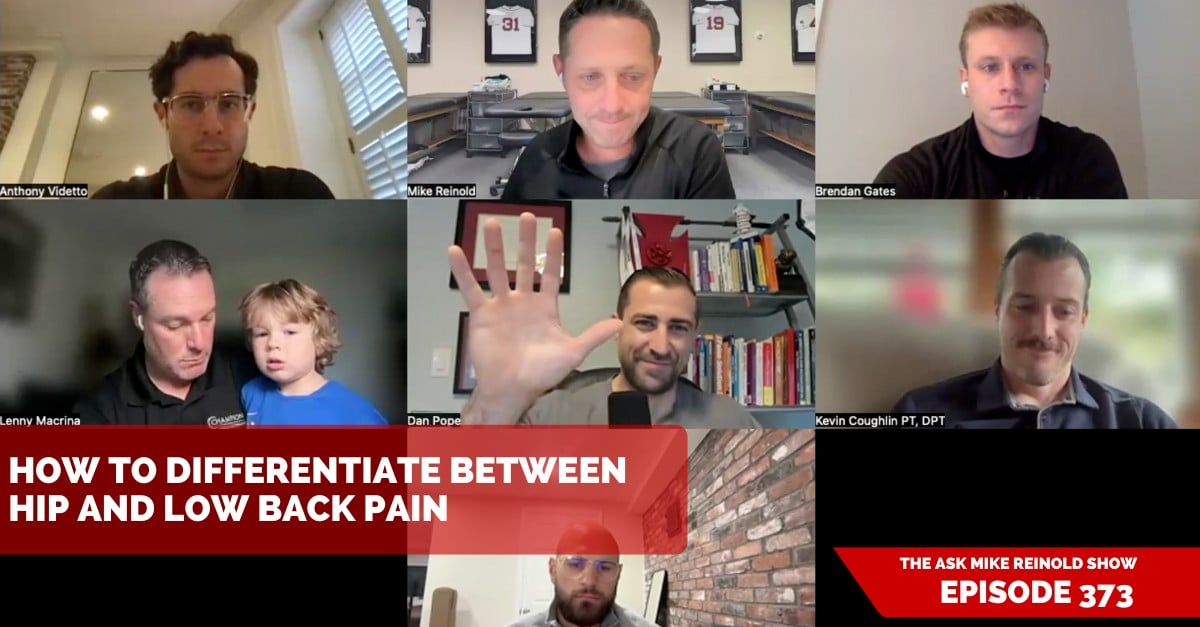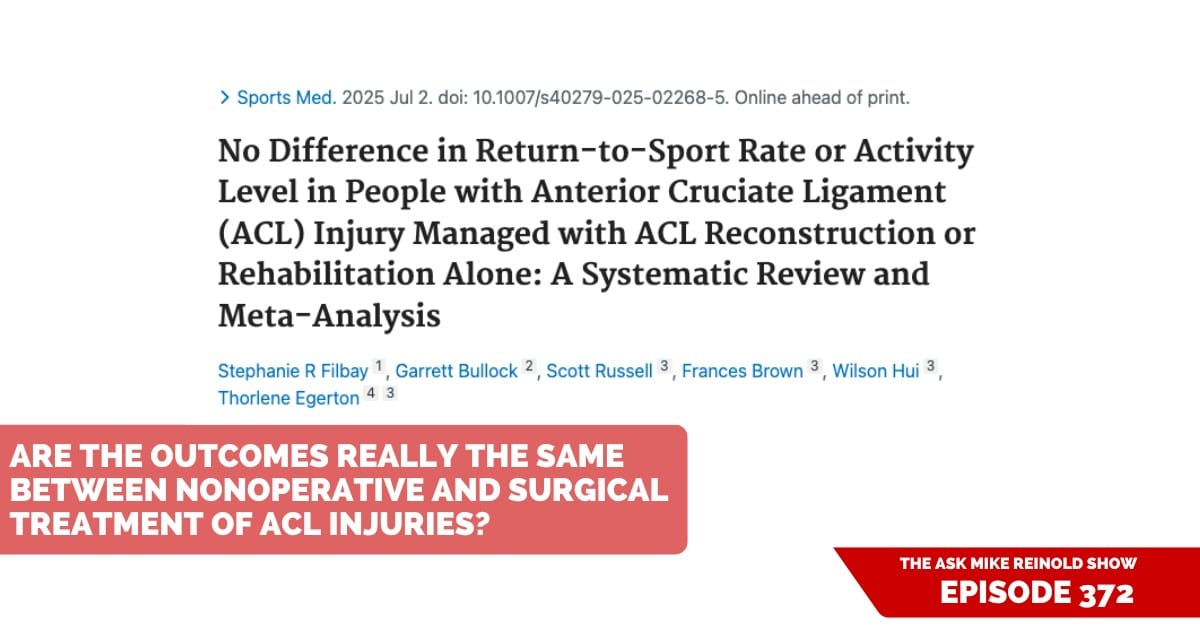Unfortunately, the failure rates of rotator cuff repair surgery are still too high, especially with large and degenerative tears.
But remember, structural failure doesn’t mean that they won’t have functional success.
In this week’s podcast, we talk about how to manage a potential acute re-tear of a rotator cuff repair.
To view more episodes, subscribe, and ask your questions, go to mikereinold.com/askmikereinold.
#AskMikeReinold Episode 256: Treating an Early Re-tear of a Rotator Cuff Repair
Listen and Subscribe to Podcast
You can use the player below to listen to the podcast or subscribe. If you are enjoying the podcast, PLEASE click here to leave us a review in iTunes, it will really mean a lot to us. THANKS!
Show Notes
- Should We Delay Range of Motion After a Rotator Cuff Repair Surgery?
- Rehabilitation Protocol Following Arthroscopic Rotator Cuff Repair
- How to Enhance Your Success After Rotator Cuff Repair Surgery
Transcript
Trevor Claridge:
Lynn Meredith from Ohio. After an open repair of complete tear supraspinatus, and subscap my patient progressed phenomenally with passive range of motion, zero pain, eventually working isometrics and active flexion with minimal hiking at 10 reps. Now at three and a half months out, she cannot hold her arm at 90 degrees abduction for seconds even, without hiking. What gives? Still just a weak cuff? She mentions a time she thinks she lifted something too heavy or did too much vacuuming with too much pain after, but was motivated based on her prior lack of symptoms.
Mike Reinold:
Okay. All right.
Mike Reinold:
So let me, let me summarize that real quick. Lynn Meredith. So supraspinatus subscap tear, that’s stinks. I wonder- I wonder if there was like a dislocation involved with that and I don’t know, but anyhow, that stinks. And doing great for three and a half months, and then all of a sudden can’t hold her arm up without a shrug. So let’s start off with like this. Is anybody- Is anybody panicked that she re-tore her cuff yet? Is it definitive she re-tore her cuff? Or are we, what do we think, does anyone want to start with that?
Lenny Macrina:
I’m not panicked, but I’m questioning I’m getting a little nervous at this point. I mean, I imagine she’s been back to the doctor if she’s 14 weeks out of surgery, so it would keep me curious what the doctor says. But if we were progressing well, I mean, this sounds like a big old tear. It was an open repair. So I think if I recall, two tendon involvement. So the chance of this re-tearing, and we don’t know her medical history, but the chance of re-tearing is pretty good.
Mike Reinold:
That’s a good point. Like over 50% right?
Lenny Macrina:
Unfortunately, I would say so. Yeah. So is it early? Yes. Would a surgeon do surgery now? No, but you know, it’s one of those, why would she progress so well and didn’t have a shrug and now she’s going to shrug. And she recalls an event that may have irritated things. And it could be that she just irritated everything. And now it needs time to calm down. But with the history of the open repair, which is unusual to do an open nowadays, I feel like if it was open, that means that there was something, a bad injury occurred and they need to really visualize the tissue. But she should have scarred down nicely, with the open repair and gotten a good repair from that. So I’m a little concerned with this current presentation.
Mike Reinold:
I’m concerned she had zero pain and was feeling great after an open repair too. I mean, those are pretty, not pain free-ish. Right?
Lenny Macrina:
Right.
Mike Reinold:
And so, interesting right there. So, all right. So I like that, a couple of things. I mean, two tears, probably. There’s probably some other factors that are going here. Those are probably big tears open all these things. She probably has what, at least a 50% chance of re-tearing this. Yeah. Somewhere around there.
Lenny Macrina:
I would say so. It’s hard without knowing her age and history and prior level of function and all that stuff. But if she’s got any kind of medical history and she’s like in her sixties or seventies, like there’s a good chance.
Mike Reinold:
Yeah. And this is, usually where- this is usually where they do tear, by the way. It’s not that they tear like nine months down the road because you know, it doesn’t work at the end range, they tear now. Right. So I do think, if you look at the literature, most people tear, more in the beginning of this process than the later portions of this process. So I think that’s, that’s pretty realistic too.
Lenny Macrina:
Her problem was she did well early on. She felt too good and, probably did too much. It’s one of those ones where you want them to scar down and get tight and pain a little. You don’t want to live through that too much, but it slows things down. It lets you- it lets you kind of, pump the brakes a little bit. Sounds like she was doing too well. So good job Lynn, that you got her motion back and all that, but yeah, hopefully not.
Mike Reinold:
You know what I’m thinking? Here’s the first thing that popped in my mind. I don’t know if this is good or bad bad Lynn, to be honest with you. But I’ve treated a lot of people with massive rotator cuff, tears and repairs. So non-operative tears and repairs that have done quite well with the supraspinatus just essentially non-existent, right. And they can do okay. Right. And we kind of talk about the suspension bridge concept with the rotator cuff, where, just like the pillars of a suspension bridge, but if your anterior and posterior cuff are doing a really good job, even without a supraspinatus, you still can elevate your arm without a hike a lot of times, if you get those really pristine. The big problem here, Lynn Meredith, is her subscap. So her subscap was a part of that. And if she had her subscap tear…
Mike Reinold:
I’m just imagining this as some sort of trauma, to be able to do this big subscap tear too, but maybe not. But now her anterior portion of her suspension bridge isn’t working well either. And that’s a problem. So I don’t know the answer if it’s re-torn. I don’t know if it was supraspinatus or subscap that re-tore, but they can both present this way. And I wouldn’t be surprised if it’s subscap too, because I mean, anything going into external rotation is going to put stress on the subscap and man that’s challenging, right? It’s a little bit easier when it’s super-infer, because we kind of avoid going in, which I think is a little easier, especially with pillow braces and stuff, but going out with functional life, that’s pretty hard. You know? And I’m just kind of thinking about that.
Mike Reinold:
So does anybody- let’s take a huge step back because I think if we look at the literature again, it doesn’t matter if your- it doesn’t matter if your tear is re-torn again, right? Your subjective and functional outcomes could still be really good afterwards if you get them really strong. So does anybody necessarily care right now? What would it change what you do if it’s torn or not torn? Or do we just more work on the functional deficit of her having a hike? What do you guys think? What do you think Dan?
Dan Pope:
Well, I Guess two things, like you said, if you start looking at some of the research and obviously there’s a lot out there and it’s a little bit mixed, but when they see the people that re-tear like a year later, usually their functions almost exactly the same, except for maybe strength, right? There’s very few things that are different between the groups. My only problem with that is that if you have a younger person with, let’s say retracted tears, we know that over the course of time, that’s going to progress faster. So if you’re lacking cuff tendons, despite feeling pretty good, let’s see at the year, mark, what is five years from now look like? What does 10 years from now look like?
Dan Pope:
So in a lot of folks, I mean, we just had a person the other day with, three tendon tears, right? Massive tears. Two of them were retracted and he has minimal pain, full range of motion, good strength. But he’s getting the surgery because he’s 42 years old and there’s a good chance that’s going to continue getting worse. He doesn’t want to be in a position where he has to get a reverse total shoulder eventually. Right? So I would say, yeah, good. And if a year later, they’re feeling great. But the other parts, like, if you got that surgery for long-term health, you’re probably in a little bit of a tough position now.
Mike Reinold:
Yeah. I would say too. I’ve seen people at this point, Lynn Meredith, where you get a little bit of a hump right here. Maybe she started doing too much. Maybe she flared it up. Maybe she didn’t necessarily, retear it. You get through the hump, you really work on strength down below. Really work on some good, dynamic stability down below. And then all of a sudden, she will get a little bit better and she’ll be able to elevate again. This could just be a hump.
Mike Reinold:
If this is prolonged. Right? And it’s like a month now and she’s still hiking the whole time. I think, send them back to the physician probably is the right step to just see what we have going on, on the inside. And nowadays too, I mean, they can, diagnostic ultrasound to check that out too. It’s not like super invasive to look at it.
Mike Reinold:
So, I guess in summary Lynn Meredith, I mean, even if it is torn, it’s not necessarily the end of the world and it’s not necessarily a bad indicator of her future prognosis, I guess. So we would do the same thing anyway, is just work on strength below 90 degrees. So that way her anterior posterior cuff, will maximize as much as they can. And she can elevate without that hike eventually over time, it just might take longer. Right. Does that make sense? So, yeah.
Dan Pope:
I just want to say something real quick. Because I think I just come off as an alarmist, you know? But I have a patient right now who’s 50 something, cuff repair, wasn’t massive. And she hit the same thing. Just had a lot of pain in the middle of a rehab, got super concerned, sent her back to the physician. Physician’s like, “you’re doing fine, not a big deal”, and she’s getting better and better, and it’s not an issue. So that’s generally what happens. But I think the other part is that as physical therapists, we have to just be conscious of what may happen in the longterm, you know? Make the best decision.
Mike Reinold:
Yeah. I feel like we can, we can create another podcast. I feel like that’d be a good title for a podcast is like the alarmist physical therapy podcast, right? What not to say.
Mike Reinold:
No, no, I think your point of view Dan, was really good on your other person. There is that it’s about your long-term function and not necessarily the status of your cuff tendon sometimes. So, just focus on the function, right. Focus on that hike and getting that as well as you can. And if you’re still having problems, then this may be one of those big enough tears that she’s going to have trouble. If it’s not fixed, if it does re-tear again, does that make sense? But man, these get harder to repair as you have to revise.
Mike Reinold:
So. Awesome. Good luck, Lynn, Meredith, appreciate the question. If you have a question like that, please head to mikereinold.com, click on the podcast link and head to Spotify, iTunes or whatever it’s called nowadays and subscribe, rate and review. And we’ll see you in the next episode. Thank you.





